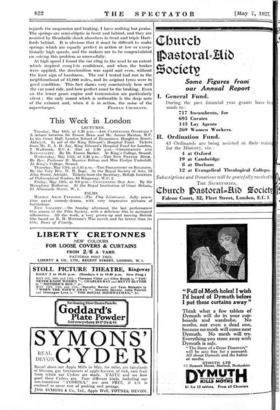Motoring Notes
The 33-180 H.P. Mercedes
I. early motoring days the novelist frequently hastened romantic journeyings of his hero by making him use a Merced —a synonym then for speed and power. Though perhaps now so heralded in fiction, the Mercedes is in fact still one the most speedy and powerful cars on the road.
One hears of fast cars which are capable of so and so, often they are so designed as to prohibit the use of top g under a speed which is too high except for the open and require a - very skilled hand at the wheel. Not so t Mercedes which, in my experience, is at once one of the ease: and most delightful of cars to handle. To begin with, steering is extremely light, and the lock is quite rernarkab Also gear-changing presents no difficulties, but is seldo required as the car will glide through traffic at ten miles hour on top gear, and yet has an amazing acceleration for any opening or emergency. There is a very deep exha note which, however, is music to the ears of an enthui and cannot be classed as unpleasant to the average passen, In the space allowed me, I can only touch on the sale points of the remarkable chassis. The 6-cylinder engine has capacity of 61 litres, an overhead camshaft, overhead vats- and a Roots type supercharger incorporated in front. T camshaft and crankshaft each rest in four bearings of is size, and the engine head can be lifted with the camshaft valve gear in place. The exhaust is taken outside the bo in three large pipes, and below them on the off-side are water pump, generator and magneto, the pump having automatic grease gun fitted to it. These parts and also t valve gear are all enclosed. No shutters are fitted to t radiator, but the temperature is under thermostatic coot with a thermometer on the dash.
A single carburetter is located on the near side of the engin of which the air pipe is automatically closed by the sup charger, which, when in action, forces air in through a differe pipe. The accelerator pedal has a certain travel wit operates solely-on the carburetter in the ordinary way. the end of that travel a further forceful depression lets in t supercharger clutch, and the blower comes into action. 1 effect is immediately noticeable by a hissing noise, and by t acceleration being at once doubled. High piston speed is a' necessary for the effectual use of the blower, that is, the blow can be used at will at ten miles an hdur or at eighty, whence very rapid acceleration is desired. On the other hand, it quite unnecessary to bring it ever into use if it is not want Without it the engine runs normally, with it the engine " forcibly fed." I wish specially to emphasize the fact th the very existence of the supercharger need not become know unless the driver so desires—the popular impression bei that a car fitted with a supercharger is something quit eccentric, and is only for the expert to drive.
Dual ignition is employed, and feed is by gravity from vacuum tank. The main petrol tank holds thirty gall° There are in all six brakes. The four-wheel brakes are ample size, and there are two brakes in addition on the wheels which are hand-operated. As well as individ adjustment for all six brakes, there is a large wheel for co bined adjustment of the operating cables.
The chassis is lubricated throughout by means of gre under pressure from a somewhat unusual type of gun whir however, was very handy to fix and of high efficiency.
Gear ratios are exceptionally high, but even on a top of a little over 3 to 1, the engine has ample power for N slow and smooth running with no suggestion of " snatching at even ten miles an hour. The gear-box is fitted with f' forward speeds and reverse, and the change is noiseless. speeds on the gears are approximately 30, 40, 60 and I m.p,h., at which last speed the engine revolutions arc 3,000.
I have not driven this car at 100 m.p.h., but the quid° of acceleration to over 90 m.p.h., and the feeling of not " all out," but of having a reserve if wanted, left no dou in my mind as to its capacity to reach three fig,ures. • regards the suspension and braking, I have nothing but praise. The springs are semi-elliptic in front and behind, and they are assisted by Houdaille shock absorbers in front and triple Hart- fords behind. It is obvious that it must be difficult to make springs which are equally perfect in action at low or excep- tionally high speeds, and the makeri are to be congratulated on solving this problem so successfully.
At high speectI found the car cling to the road to an extent which inspired collar hte confidence, and when the brakes were applied, the deceleration was rapid and even, without the least sign of harshness. The call tested had run in the neighbourhood of 15,000 miles, and its original tyres were in good condition. This fact shows very conclusively how well the car must ride, and how perfect must be the braking. Even on the lower gears engine and transmission are particularly silent ; the only sound which is noticeable is the deep note of the exhaust and, when it is in action, the noise of the















































 Previous page
Previous page